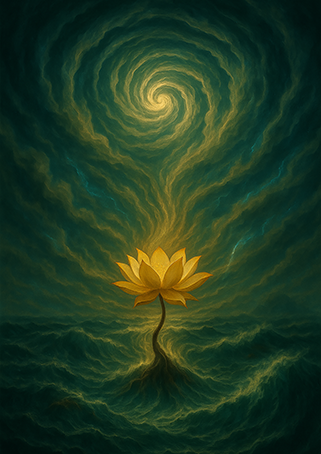Xieyi・The Rootless Tree:24 Chapters-Chapter 1#302

The poems of “The Rootless Tree” express a fundamental force rooted in harmony with heaven and earth, the cyclical flow of yin and yang, and the infinite potential of existence。
This painting is an expressive Xieyi in the tradition of “futu” (spiritual diagrams), passed down for generations in Wudang Mountain, China. It is drawn through a technique where energy flow (xingqi) channels the internal intention into visual form。 In the Taoist world, there exist spiritual and symbolic images called “futu”。
In the Taoist world, there exist spiritual and symbolic images called “futu”。
These are a type of talisman—not merely religious items, but expressive spiritual paintings that act directly on the mind of the viewer。
Since ancient times, many people have placed these Taoist-style “Xieyi” and futu in their homes, studies, or bedrooms, wishing for longevity, health, auspiciousness, and family harmony. Viewing such paintings was not just aesthetic appreciation, but an act of inviting the presence of the Dao into one’s life and tuning the body and mind。
Thus, “Xieyi” is more than artistic expression—it is a medium that bridges the spirit, life, and harmony with the universe。
This kind of artwork is not meant to be seen only with the eyes, but felt with the heart。
It communicates with the Dao, resonates with the qi of nature, and quietly stirs the viewer’s inner self。
Futu and “Xieyi” continue to live on from ancient times to this day as “sacred images that speak to the soul.”
Below, we present the original text of the philosophical poem “The Rootless Tree,” along with a modern Japanese translation and interpretation。
※ The author of “The Rootless Tree,” Zhang Sanfeng (1247–?), is also renowned as the founder of Tai Chi, and it is said that he applied the essence of this work to Tai Chi. As an additional note, we include an interpretation connecting this to the Tai Chi tradition of Wudang Mountain.
The Rootless Tree・Chapter 1

▶Original Text
無根樹,花正幽,貪戀紅塵誰肯修?浮生事,苦海舟,蕩去飄來不自由。無邊無岸難泊繫,長在魚龍險處游。肯回首,是岸頭,莫待風波壞了舟。
▶Modern Translation
A flower quietly blooms on a rootless tree.
In this world filled with desire, who will choose the path of self-cultivation?
The course of life resembles a boat adrift on a sea of suffering.
Tossed and swept away, never able to go where one wishes.
There is no end in sight, no shore, no place to anchor one’s vessel.
Always drifting in perilous waters, there is the constant fear of being swallowed by dragons or fish.
But—if only you would look back, you would see the shore lies just behind you.
Before the waves destroy your boat, please awaken.
▶Interpretation
This verse offers a quiet yet profound warning: it speaks of human delusion, the potential for awakening, and the peril of missing the right moment.
• “A flower quietly blooms on a rootless tree”:
The subtle and serene beauty of this “faint flower” reflects a depth beyond ordinary perception—a symbol of profound inner stillness moving toward a state of freedom, detached from worldly roots.
• “In this dusty world of desire, who willingly cultivates the Way?”:
A reflection on the reality that few seek self-cultivation when consumed by the whirlpool of cravings.
• “Life is like a drifting boat on the sea of suffering”:
Life, like a water plant, floats uncontrollably, and the image of a boat on a stormy sea conveys a sense of helplessness and lack of freedom.
• “No shore in sight, no anchor to hold”:
This implies that in the worldly realm, there is no certain refuge or foundation—one is always exposed to danger.
• “If you would turn back, you would find the shore”:
A Taoist teaching recalling the classic phrase “Return, and you will find the shore”, pointing to salvation through awakening.
• “Do not wait until the waves destroy your boat”:
A powerful exhortation: wake up before it’s too late.
▶Interpretation related to Tai Chi
This poem carries significant lessons for practitioners of Tai Chi as well.
• Do not rely solely on form:
If one becomes intoxicated by external techniques and loses “still power,” the form may appear graceful, but it will eventually collapse.
• Have the courage to choose the path of cultivation:
Rather than chasing praise or flashy forms, it is the quiet, solid practice—often shunned—that leads to true mastery.
• Do not drift—take the helm:
Merely repeating forms mindlessly is meaningless. Without your own internal direction (Qi momentum), you’ll drift without control.
• Danger is ever-present in daily practice:
Even slight negligence can collapse the entire structure of one’s technique. Tai Chi is about always “swimming naturally and effortlessly.”
• Awaken—here and now:
Instead of forcibly doing, we should return to Wu Wei, the state of effortless action. The shore is right behind you—so awaken before it’s too late, in this very moment.
Copyright © MASAKI WAKABAYASHI. All rights reserved.




